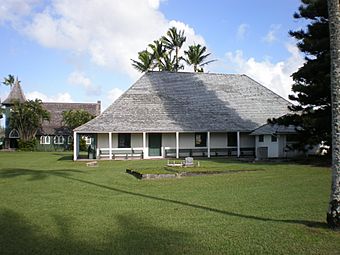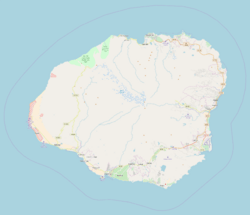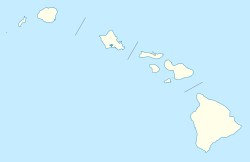Waiʻoli Mission District facts for kids
Quick facts for kids |
|
|
Waiʻoli Mission District
|
|

Church and Mission Hall
|
|
| Location | Off Route 560, Hanalei, Hawaii |
|---|---|
| Area | 17 acres (6.9 ha) |
| Built | 1832 |
| Architect | Hart Wood |
| Architectural style | Gothic |
| NRHP reference No. | 73000676 |
| Added to NRHP | October 3, 1973 |
The Waiʻoli Mission District is a special historical place located at Hanalei Bay on the island of Kauaʻi, Hawaii. You can find it along Route 560 on the north shore. This area became home to the first permanent missionaries in 1834. Because of its important history, the district was added to the National Register of Historic Places in 1973.
Today, the main building, known as the Waiʻoli Mission House, is a museum. It's open to everyone who wants to learn about its past.
Contents
What Does Waiʻoli Mean?
The name Waiʻoli comes from the Hawaiian language. It means "joyful water" or "singing river." It's a beautiful name for a beautiful place!
Early Days of the Mission
The story of Waiʻoli Mission began even before the missionaries settled there. In 1824, a royal ship called Haʻaheo o Hawaiʻi ("Pride of Hawaii") got stuck in the bay. Many people gathered to try and save it. A minister named Reverend Hiram Bingham used this chance to share an important message with the crowd.
Around 1832, a small hut with a thatched roof was built in this area. It was a place for missionaries from the American Board of Commissioners for Foreign Missions to stay when they visited from other parts of the Hawaiian Islands. Important leaders like island governor Kaikioewa and Queen Dowager Deborah Kapule supported these early efforts.
The First Permanent Missionaries
The first permanent pastor, Reverend William Patterson Alexander, arrived in 1834 with his wife, Mary Ann McKinney Alexander. They quickly rebuilt the temporary hut. Reverend Alexander also started building a wooden house around 1835. Their son, Samuel Thomas Alexander, was born right there in the mission house.
Building the Church and Home
In 1837, a big storm blew down the second thatched church. So, work began on a stronger, wooden church building. It was finished in 1841. This new church was a rectangular building, about 35 feet wide and 70 feet long.
As the Alexander family grew, their house also needed more space. Reverend Alexander expanded it to fit everyone. While most mission houses in Hawaii looked like homes from New England, this one had a different style. It showed influences from the Southern United States, probably because Alexander was born in Paris, Kentucky.
New Teachers and Families
In 1837, Edward Johnson and his wife Lois Hoyt Johnson arrived and started a school. Later, in 1843, George Berkeley Rowell and his wife Malvina Jerusha Chapin Rowell joined the mission. The Alexanders then moved to Lahainaluna School.
In 1847, Abner Wilcox and Lucy Eliza Hart Wilcox came to Waiʻoli as teachers. This happened after the Rowells moved to another mission in Waimea. Edward Johnson then became the pastor of the church.
Changes Over Time
By the late 1840s, the American Board stopped providing money for the missions. Instead, they created a group called the Hawaiian Evangelical Association. This group tried to raise money by having small farms at each mission site.
After a big land division called the Great Mahele, the Wilcox family officially owned the property. The mission school eventually became the Hanalei Public School. Sadly, Abner and Lucy Wilcox both passed away in 1869 while visiting family in Colebrook, Connecticut. Their son, Albert Spencer Wilcox, lived in the mission house until 1877.
A New Church and Restorations
In 1912, a new church building was constructed. It was built with money donated by Sam, George, and Albert Wilcox. These were the sons of the missionary couple, and they had been born at the mission. The older 1841 church building was then used as the Mission Hall. The original mission bell was moved to the belfry of the new church.
In 1921, the Wilcox family descendants hired an architect named Hart Wood to restore the Mission House and the Mission Hall. Later, by 1945, the Waiʻoli church joined with the Anini Church and the Haena Church. Together, they became the Huiʻia Church. Huiʻia means "united" in Hawaiian.
You can still see some of Abner Wilcox's old books in his study at the mission house. In 1957, the Congregational Church organization became the United Church of Christ.
The Mission District Today
The Waiʻoli Mission District covers about 17 acres. It includes the original 1836 mission house, two small cottages for caretakers, and a garage. Of course, it also has the 1841 Mission Hall and the 1912 Church. The mission house is now a small private museum, offering a glimpse into the past.
Images for kids











